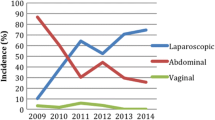Abstract
Objective
Our goal was to compare postoperative pain and analgesic requirements regarding closure and non-closure of the peritoneum in women undergoing laparoscopic supracervical hysterectomy (LSH).
Study design
A prospective cohort study was designed to investigate the impact of peritoneal closure for LSH. Postoperative pain was measured by a visual analogue scale (VAS) and analgesic requirements were assessed. Intra- and postoperative complications and operative time were recorded.
Results
A total of 104 patients were enrolled. Fifty-two (50 %) women underwent a LSH with peritoneal closure and 52 (50 %) underwent LSH without closure. The baseline characteristics were well balanced between the groups except for age; women undergoing LSH without peritoneal closure were significantly younger (p < 0.008, t test). The median operative time was 53 (26–105) minutes for LSH with peritoneal closure and 44 (24–83) minutes for LSH without peritoneal closure, a median reduction of 9 minutes (p = 0.007). No differences were found in uterine weight, intra- and post-operative complications, median haemoglobin drop or time in hospital when contrasting both groups. Both groups had similar VAS-pain scores and needed similar analgesic therapies.
Conclusions
The peritoneal closure at LSH provides no short-term postoperative advantages over a non-closure approach, and it prolongs the operative time and anaesthetic exposure. Our data suggest that peritoneal closure is not necessary in LSH.
Similar content being viewed by others
References
Pietrantoni M, Parsons MT, O’Brien WF et al (1991) Peritoneal closure or non-closure at cesarean. Obstet Gynecol 77:293–296
Rafique Z, Shibli KU, Russell IF et al (2002) A randomised controlled trial of the closure or non-closure of peritoneum at caesarean section: effect on post-operative pain. BJOG: an international journal of obstetrics and gynaecology 109:694–698
Højberg KE, Aagaard J, Laursen H et al (1998) Closure versus non-closure of peritoneum at cesarean section–evaluation of pain. A randomized study. Acta Obstet Gynecol Scand 77:741–745
Janschek EC, Hohlagschwandtner M, Nather A et al (2003) A study of non-closure of the peritoneum at vaginal hysterectomy. Arch Gynecol Obstet 267:213–216
Kucuk M, Okman TK (2001) Non-closure of visceral peritoneum at abdominal hysterectomy. Int J Gynaecol Obstet Off Organ Int Feder Gynaecol Obstet 75:317–319
Gupta JK, Dinas K, Khan KS (1998) To peritonealize or not to peritonealize? A randomized trial at abdominal hysterectomy. Am J Obstet Gynecol 178:796–800
Nieboer TE, Johnson N, Lethaby A et al (2009) Surgical approach to hysterectomy for benign gynaecological disease. Cochrane Database System Reviews:CD003677
Weerawetwat W, Buranawanich S, Kanawong M (2004) Closure vs non-closure of the visceral and parietal peritoneum at cesarean delivery: 16 year study. J Med Assoc Thailand Chotmaihet Thangphaet 87:1007–1011
Behtash N, Ghaemaghami F, Gilani MM et al (2001) To peritonealise or not to peritonealise? A randomised trial at abdominal hysterectomy in Iran. J Obstet Gynaecol J Institute Obstet Gynaecol 21:520–524
Franchi M, Ghezzi F, Zanaboni F et al (1997) Nonclosure of peritoneum at radical abdominal hysterectomy and pelvic node dissection: a randomized study. Obstetrics and gynecology 90:622–627
Milad MP, Morrison K, Sokol A et al (2001) A comparison of laparoscopic supracervical hysterectomy vs laparoscopically assisted vaginal hysterectomy. Surg Endosc 15:286–288
Hoffman CP, Kennedy J, Borschel L et al (2005) Laparoscopic hysterectomy: the Kaiser Permanente San Diego experience. J Mini Invasive Gynecol 12:16–24
Mueller A, Renner SP, Haeberle L et al (2009) Comparison of total laparoscopic hysterectomy (TLH) and laparoscopy-assisted supracervical hysterectomy (LASH) in women with uterine leiomyoma. Euro J Obstet Gynecol Reprod Biol 144:76–79
Washington JL (2005) Laparoscopic supracervical hysterectomy compared with abdominal, vaginal, and laparoscopic vaginal hysterectomy in a primary care hospital setting. JSLS J Soc Laparoend Surg/Soc Laparoend Surg 9:292–297
Funding
This study was not funded.
Author information
Authors and Affiliations
Corresponding author
Ethics declarations
This article does not contain any studies with animals performed by any of the authors. All procedures performed in studies involving human participants were in accordance with the ethical standards of the institutional and/or national research committee and with the 1964 Helsinki declaration and its later amendments or comparable ethical standards.
Informed consent
Written informed consent was obtained from all patients before treatment. An additional individual consent for this analysis was not needed.
Conflict of interest
All authors declare that they have no conflict of interest.
Rights and permissions
About this article
Cite this article
Eggemann, H., Mitrik, N.A., Kabdebo, O. et al. Peritoneal closure during laparoscopic supracervical hysterectomy. Arch Gynecol Obstet 294, 785–789 (2016). https://doi.org/10.1007/s00404-016-4125-7
Received:
Accepted:
Published:
Issue Date:
DOI: https://doi.org/10.1007/s00404-016-4125-7




